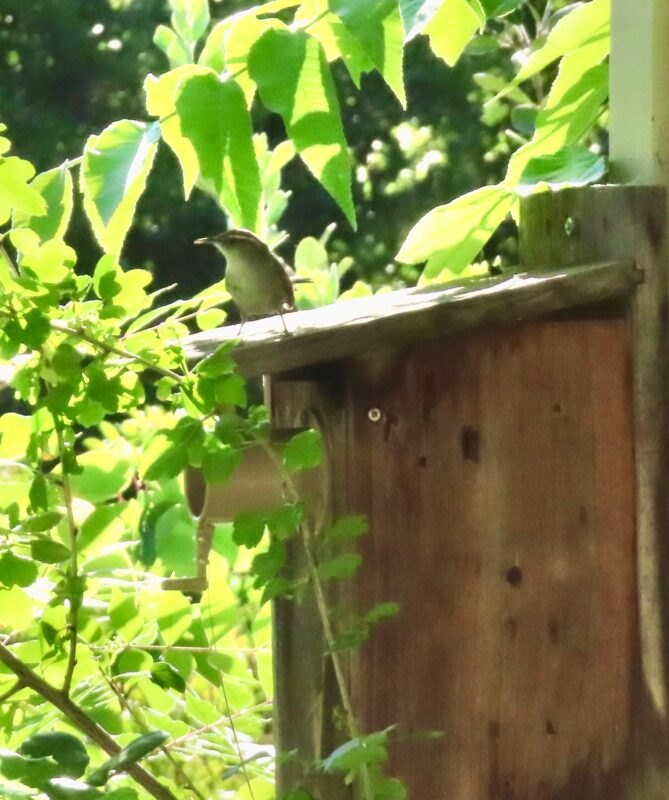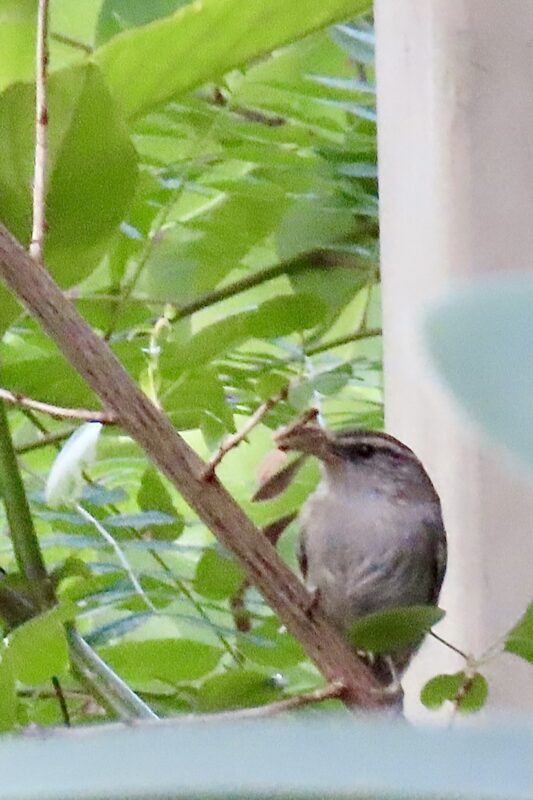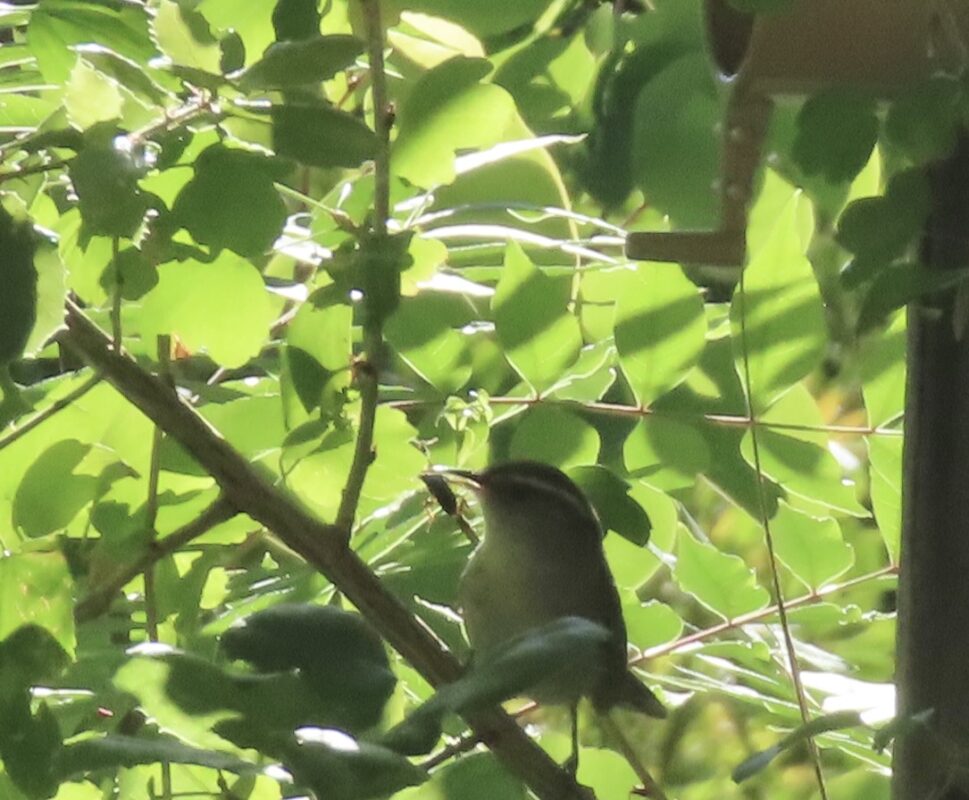A few things prompted this post; first, I found an injured hummingbird, which I rushed to a local rehabber, where I learned suggestions to help ailing birds. Then there are the foxes. Seems our half-acre yard has hosted so many wildlife births and critter wanderings this spring. I even got to document how many insects a baby bird needs to survive.
We’ve had our place in Redlands CA for 15 years now, and while preservation of its mature tree and shrub cover (we call it ‘the jungle’) is primary, we also replaced the front lawn with mostly California natives and plugged them in elsewhere on our property. Why native plants? Because they support the most habitat-friendly environment possible in your yard — whether you’re limited to a balcony, or have a half-acre like us or more.
It’s worked. Here are some recent stories – click here for a previous critter tales.
Roaming Foxes – where is the fox den?


Our parrots first let us know with their screams – something was out there, a cat or raccoon, maybe a fox. We saw the latter, and later our camera showed two adult gray foxes. One photo showed a pink belly that sure looked like a lactating mother fox, which Project Coyote founder and carnivore expert Camilla Fox confirmed. For a couple weeks we heard them barking many nights, which they use as a warning or to denote their territory. Being omnivores, lately they’ve been eating our loquat fruit and our manzanita berries. Our hope is they catch the rats on our property.
They sure have adopted our half-acre as territory but we can’t find where a den would be located. It’s likely nearby. We keep a look out for their pups.

Baby Birds Need Insects (my count showed over 260 a day!)
Since we’ve emphasized grasses, shrubs and trees native to our SoCA area we’ve noted more and more butterflies, moths, caterpillars, spiders and native bees and other insects. Then came the birds. Our berry-producing shrubs also attracted them. (click here for even more critter stories from our yard.) This spring a bunch of birds (particularly California towhees, mockingbirds, jays and a primo insect-eater called the Bewick’s wren) busied themselves carrying sticks, fuzz and even foam from some neighbor’s outdoor furniture for nest building. We knew some were nesting in a huge hedge on our property, and we witnessed two Bewick’s wren couples building nests.
Good timing in that my hip replacement recovery coincided with the busiest feeding time for the Bewick’s wren nestlings. Being pretty sedentary, I decided to count the trips to the nest, and document how many and what types of insects were being fed. Did you know that insects provide the proteins, fats, and other nutrients baby birds need to grow? If you want birds on your property you need to have insects around.





Here is what I found:
- Our wren couple fed over 260 insects a day to their babies – when they fledged a couple days later, we counted two for sure, but think three (it happens very fast!)
- What insect types? I couldn’t id many of them but moths and craneflies (the insect of the week) seemed to top the list. Of the rest, caterpillars, spiders, bees and flies along with other nondescript smaller insects next
- As expected, the parents were busiest right after dawn and at dusk. The hourly numbers of insects ranged from a low of 4 one day (early afternoon, siesta time?) up to 19 during the couple hours before sunset.
- To learn more about native plants and insects, check out your state’s native plant society such as Calscape for Californians. I also have lots of articles on my website.
Tips to Avoid Hummingbird and other Bird Injuries/Problems

I was walking down one of our property’s paths a couple weeks ago and saw something flutter. I realized it was a hummingbird; it tried flying but fell down into the vegetation. A baby I immediately thought and got a large cup, cut off the top and put leaves in it and tied it on a branch, not seeing any nest around (if you see a nest, put the baby in there – it’s not true that the parents won’t come back). But the more I looked, it didn’t seem like a baby and a bird rehabber I sent a photo to confirmed it was an adult female Allen’s hummingbird.
I drove 40 minutes to deliver it to Morgan Bane, one of several certified hummingbird rehabbers in the LA area. ‘My girl’ is one of 90 they have in their hummingbird program.
Morgan said a little over half survive to be released back in the wild – my girl is flying but still not well enough to be released (they prefer to release them where they’re found.) Most likely she suffered a head injury. I asked Morgan Bane how people can help so that fewer hummingbirds come to rescuers.
Primary reasons hummingbirds and other birds need intervention – and how to prevent
- Window strikes due to windows that are reflective (this is a major cause for all birds) We use reflective stickers and like WindowAlert but there are other options.
- Cats catch them because people don’t keep cats indoors, but let them roam freely. I’ll never forget one house we looked at in San Diego County when moving there. A woman had a bunch of hummer feeders but also had a couple cats roaming the backyard. I asked if they ever caught a hummingbird and she replied that she makes a lot of trips to bird rehabbers. Sorry, not right….
- Poor hummingbird feeder care causes sticky feathers or fungal infections of the mouth; In hot weather, feeders should be cleaned at least every other day. Click here for more info.
- Taking them from the wild when the parents are nearby. “Well meaning people think a nest is abandoned, when in reality the mother is no longer sitting on them because they are too big. People bring them in and attempt to raise them, until they realize they don’t have the education or tools — we get contacted and get birds that are badly damaged feather-wise or starved,” says Morgan.
- People who trim trees and hedges in the middle of spring time “not thinking that springtime is the time of new life and that’s when nests are active.” See when to trim trees.
- And then just ignorant people who take down nests to play with the birds until somebody with a conscience takes them away.
- See www.ifoundahummingbird.com to learn more about hummingbird rehab and hummingbird behaviors. “There are a lot of useful sites like The Audubon Society and Cornell Lab’s e-Bird that will give you facts about hummingbirds. I would recommend people arm themselves with valid information, and share that with her family and friends,” says Morgan.
Click here for another more tips on finding a baby animal, which provides local (SoCA) rehab contacts.
Excellent article, Linda! So much useful information in here. I hope it reaches so many people. It’s great to see you writing again. :)